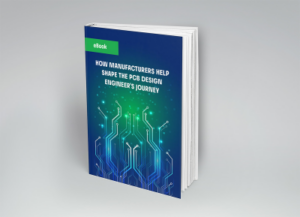
An engineer reacting to an AI electronic circuit design for a complex problem in 2025
The question of when effective AI tools for PCB design would arrive has been answered. The future is now. In fact, with generative AI tools like ChatGPT, you can talk through your board design. Amazing, yes! The expansion of capabilities shown by AI tools over the last couple of years is impressive.
However, there are still concerns, and the expertise and guidance of an engineer are still required to optimize the usage of these tools. By understanding what programs are available, the extent of reliable PCB design support capabilities, and following good guidelines, you can take advantage of AI electronic circuit design to improve your workflow efficiency.
How AI Tools Are Transforming Circuit Design
After some initial skepticism, PCB designers and engineers are starting to embrace AI techniques and tools, similar to other technical disciplines. Software programs that are leading this transformation are listed below.
| TOP AI ELECTRONIC CIRCUIT DESIGN TOOLS | |||
| Tool | Design Application | AI Utilization | Suggested Use Case |
| Allegro X AI | PCB Layout Optimization | Generative AI for trace routing | Complex mixed-signal boards |
| DeepPCB | Automated Layout & Verification | Component placement, DRC checks | High-density designs |
| Quilter | Layout Optimization | Multiple solution generation | Multi-layer PCB routing |
| CADY | Schematic Inspection | Datasheet verification | Component accuracy validation |
| CELUS | Schematic Design | Automated BOM generation | Rapid prototyping |
| Flux | Integrated Design Support | Decision support system | End-to-end design workflow |
| Optimality Explorer | System Analysis | Process optimization | Complex system design |
| Wizer | Component Selection | Alternative part analysis | Supply chain optimization |
As shown above, AI techniques and paradigms are being leveraged to help engineers with many of the most challenging aspects of the PCB design process; such as optimizing component selection, effectively using datasheets, comprehensive BOM generation, and verifying your design. Moreover, Generative AI techniques are revolutionizing PCB design workflow by personalizing the user experience (UX).
PCB Design with Generative AI
Generative AI tools bring the power of iterative machine learning (ML) to the circuit board design process. By leveraging defined datasets and the ability to add new knowledge, these tools provide adaptability or personalization that can significantly speed up key essential processes; such as component placement, trace routing, and design verification and optimization.
Key Generative AI Capabilities
💡 Smart layout selection:
AI systems can generate multiple layout options based on design constraints, allowing engineers to evaluate trade-offs between performance, cost, and manufacturability. These tools analyze thousands of design patterns to suggest optimal component arrangements.
💡 Intelligent trace routing:
Advanced algorithms consider signal integrity, crosstalk, and thermal management simultaneously. Generative AI can propose routing solutions that human designers might not consider, often finding more efficient paths through complex multi-layer boards.
💡 Evaluation and Refinement:
AI continuously refines designs based on performance feedback, automatically adjusting parameters to meet specifications while minimizing cost and board space.
As the momentum and implementation of AI electronic circuit design increases, engineers report significant improvements in design efficiency. Specifically, smart automated routing reduces design cycles, intelligent layout improves overall design quality, resulting in better performance, and optimized design helps facilitate smooth fabrication and assembly processes. Reaping the benefits of integrating AI into your PCB design process does require consideration, and the best results will be achieved by following well-defined guidelines.
Implementation Guidelines for AI Circuit Design
Successfully integrating AI tools into your circuit design workflow requires systematic planning and careful validation. By following proven implementation strategies, as exhibited by the three-stage approach below, you can maximize benefits while avoiding common pitfalls.
AI Electronic Circuit Design Guidelines
Phase 1: Application AssessmentIdentify Target Areas: Begin by mapping your current design process to identify tasks that consume significant time or are prone to error. Common targets include:
Tool Selection Criteria: Evaluate AI tools based on integration capabilities with existing EDA software, learning curve requirements, and specific application strengths. Consider starting with tools that address your most time-consuming design bottlenecks. |
Phase 2: Pilot ImplementationStart Simple: To build confidence in AI tool capabilities, begin with straightforward, easily verifiable projects. Simple two-layer boards with standard components provide ideal testing grounds for new AI workflows. Validation Process: Establish multi-stage validation procedures:
|
Phase 3: Scaling and OptimizationProgressive Complexity: Gradually apply AI tools to more complex projects as team confidence grows. Monitor results carefully and adjust tool settings based on project outcomes. Team Training: Invest in comprehensive training to help team members understand AI tool capabilities and limitations. Effective AI implementation requires engineers who can guide and validate AI outputs effectively. |
Following the guidelines above will help you identify where AI electronic circuit design tools could be most beneficial as well as aid you in minimizing any associated learning curve for implementation with your specific EDA tool(s). However, the utilization of AI tools does present potential risks that must also be addressed.
Optimizing AI Tool Performance
While AI tools offer significant productivity benefits, maintaining design accuracy requires careful attention to data quality and validation processes. For example, component model accuracy becomes particularly critical when AI systems are relied on to make automated decisions based on part specifications. In fact, inaccuracy is the most common root cause of low-quality or poor results from an AI engine. Consequently, it is critical that you source data and information from reliable resources. This is particularly important for component models and design rule compliance.
Component Model and Design Rule Accuracy
AI tools are only as reliable as their underlying data, and you must ensure component libraries come from verified sources with comprehensive, up-to-date specifications. Ultra Librarian, which provides the largest online CAD model library for PCB designers and engineers, meets this requirement by verifying model information with the industry’s leading manufacturers. Additionally, CAD models adhere to recognized industry standards for schematic symbols, footprints, and 3D CAD models.
For multilayer PCBs, AI routing tools must consider complex interactions between layers; such as via placement and signal integrity requirements. It is crucial to depend only on verified component datasheets and other vetted information sources and ensure that industry standards for placement, spacing, and clearance are adhered to. Ultimately, how well your AI electronic circuit design tool satisfies your objectives depends on how well you manage the data it relies on.
Optimizing your AI PCB design implementation requires that you:
- Define areas of your design workflow for improvement
- Select an EDA-compatible tool that has the desired capabilities
- Familiarize yourself with the tool on a known or simple problem
- Ensure that your AI solution tool is scalable
- Only source component data from reliable sources
- Make sure design rules adhere to industry standards
- Verify your PCB design result(s)
The key to successful AI implementation lies in understanding that these tools amplify human expertise rather than replacing it. By combining AI efficiency with human insight and validation, design teams can achieve faster development cycles, improved design quality, and enhanced innovation opportunities.
If you’re looking for CAD models for common components or the most pertinent information on AI electronic circuit design tools and implementation, Ultra Librarian helps by compiling all your sourcing and CAD information in one place.
Working with Ultra Librarian sets up your team for success to ensure streamlined and error-free design, production, and sourcing. Register today for free.








